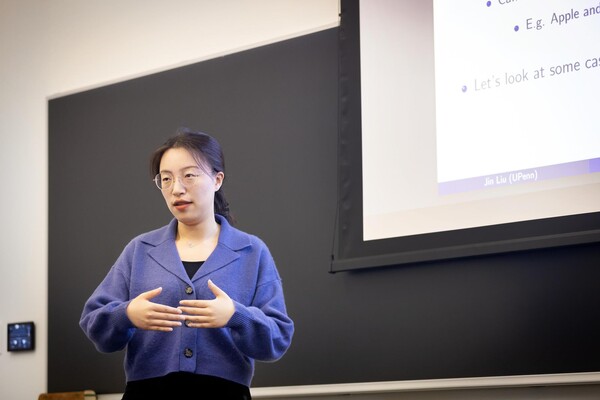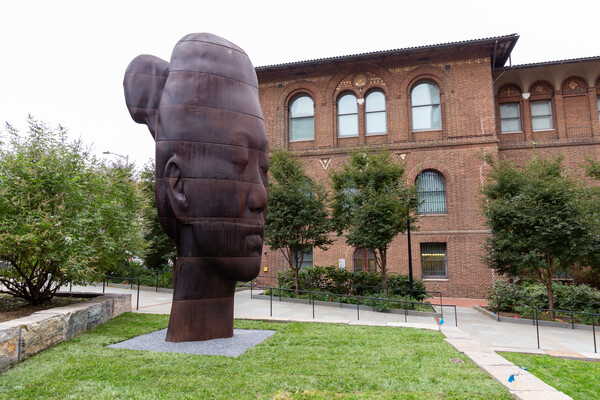
(From left) Doctoral student Hannah Yamagata, research assistant professor Kushol Gupta, and postdoctoral fellow Marshall Padilla holding 3D-printed models of nanoparticles.
(Image: Bella Ciervo)

A collection of home movies, dating from 1930 to 1961, in the University Archives & Records Center, chronicle the lives of pioneering civil rights activists Raymond Pace Alexander (1897–1974) and Sadie Tanner Mossell Alexander (1898–1989), two Penn trailblazers.
In 1921, Sadie Tanner Mossell Alexander became the first African American woman to earn a Ph.D. at Penn after earning a bachelor’s degree in 1918, and a master’s degree in economics in 1919. She went on to become the first African American woman to earn a law degree from Penn, in 1927. With degrees from the Wharton School and Harvard Law, her husband Raymond Pace Alexander established a legal practice in Philadelphia to serve African American and underrepresented communities.
The couple became well known for their legal work, particularly their civil rights cases fighting discrimination and segregation.
More than 100 black-and-white and color 16mm silent films are included in the Alexander Family Papers collection, says J.M. Duffin, assistant University archivist. The films document the professional and personal lives of Raymond and Sadie Alexander, as well as some of their family members. The University Archives digitized some of the films, starting in 2018. Duffin wrote about the process in a Unique at Penn blog post.
“The Alexanders are two very significant Penn alumni from the 20th century who had a major impact as leaders in the African American community,” Duffin says.
The Alexander home movies capture personal and social life, including children making contributions to a nursery school lunch fund in the early 1940s, children riding bicycles (in color), and cutting birthday cakes, at a wedding, and a 1930s birthday party for Raymond Alexander’s father Hillyard Alexander (who was enslaved at birth in Virginia). Another film shows the family visiting with famous contralto Marian Anderson in the late 1940s or early 1950s at her home in Connecticut. Penn Libraries holds her archives in the Marian Anderson Collection.
“These films give a fresh perspective on the Alexanders, who they were and also the people they interacted with,” says Duffin. “A nice thing about the films is that they capture them in several different settings. They document the private as well as public life of the Alexanders and offer a rare motion picture glimpse into the world of an upper-middle-class Philadelphia African American family.”
The films provide a glimpse into the Alexander’s prominent role in the national Civil Rights Movement. The oldest films in the collection are from 1930, Duffin says, including footage from the 1930 meeting at Howard University of the National Bar Association, founded in part by the Alexanders in 1925 when African Americans were denied membership in the American Bar Association. Another 1930 meeting captured is the National Urban League in Buffalo, which shows Thurgood Marshall, who would become a U.S. Supreme Court Justice. Other group events found in the collection include the 1932 Republican National Convention in Chicago.
The footage also includes footage of trips made by Raymond and Sadie Alexander to Europe in 1930 and 1931. Their first trip was to France, Germany and England; when in France, they visited Sadie’s uncle, the artist Henry Ossawa Tanner. In 1931 the Alexanders visited Germany and the Soviet Union; where they were invited to attend a session of a Soviet court and allowed to film it. The Alexanders’ trips to the Caribbean in the 1930s and ’40s provide a glimpse at communities in Haiti, Santo Domingo, St. Thomas, St. Croix, Jamaica, and Martinique
The availability of amateur or home-movie cameras in the U.S. began in the early 1920s, after Kodak created a motion-picture camera and an infrastructure across the country to process the 16mm non-flammable safety film (cellulose acetate). The Alexanders had a Bell & Howell Filmo camera. Duffin says that the Alexanders likely hired a professional film editor to put together some of the footage because there are intertitles or tile cards, common to silent films, identifying locations and sometimes individuals.
The films are important for many reasons, including research: Some footage was included in a PBS series American Masters documentary that aired in 2022, “Marian Anderson: The Whole World in Her Hands.” The footage with Henry Ossawa Tanner was included in “Myth of a Colorblind France,” a documentary about African American artists who had moved to Paris.
The Archives collects personal papers of alumni “because it’s part of preserving the history of the University, and part of that history is how Penn affects the world,” Duffin says.
From the Archives features items in Penn’s University Archives & Records Center, which holds University records and materials related to faculty and alumni.
Louisa Shepard

(From left) Doctoral student Hannah Yamagata, research assistant professor Kushol Gupta, and postdoctoral fellow Marshall Padilla holding 3D-printed models of nanoparticles.
(Image: Bella Ciervo)

Jin Liu, Penn’s newest economics faculty member, specializes in international trade.
nocred

nocred

nocred